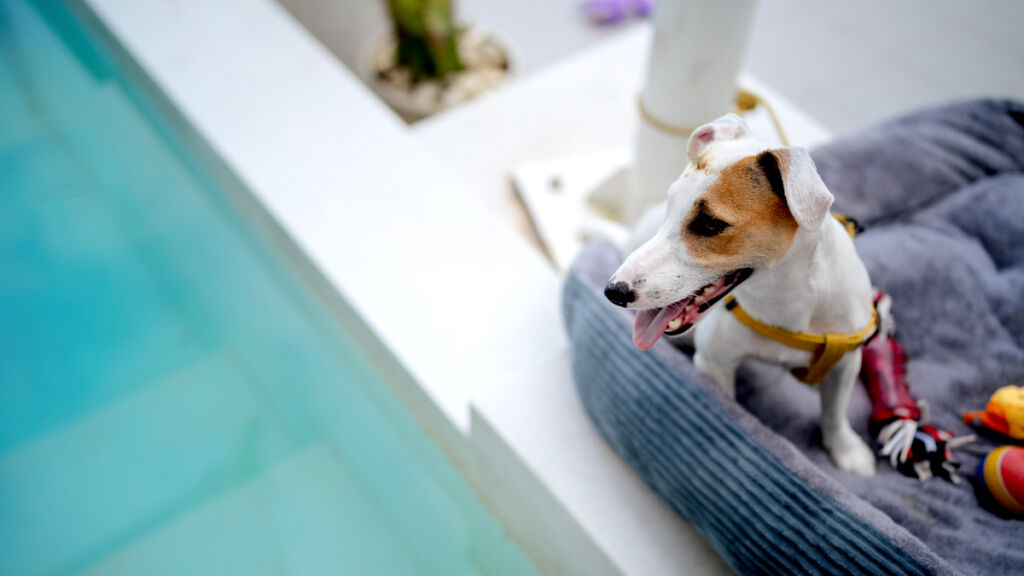Discover whether it’s a good idea to let your dogs in pool water
Imagine a scorching sunny day – as you bask in your swimming pool’s refreshing waters, your dog’s excited tail wags tell you they’re eager to dive in. But, is it really okay to let your dog in the pool for their well-being and your pool water quality? The answer isn’t as straightforward as it seems.
In this comprehensive guide, we share expert insights, best practices and crucial factors to consider before allowing your beloved canine to take a dip in your pool.
The Pros of Letting Your Dog in the Pool
Dogs and water is a combination that often leads to happy moments of splashing and laughter. Here are some of the many benefits of letting dog swim:
- Physical Fitness and Play: For most dogs, the idea of playing in the water is irresistible. It serves as a fun outlet to exercise and play.
- Deepened Bonds: Swimming side by side cultivates a unique bond, enhancing the camaraderie between you and your canine companion.
- Cooling Down: Pools offer relief from hot weather, helping your pup stay comfortable in scorching temperatures.
- Joint Health: Swimming’s low-impact nature proves particularly advantageous for aging or arthritic dogs, ensuring their joint health.
The Cons and Considerations for Dogs in Pools
While some dogs are natural-born swimmers, others might not share the same sentiment. Before you toss the tennis ball into the pool, let’s address important factors and potential concerns:
- Breed Composition: Not all dogs are natural swimmers; some breeds struggle due to their body physical attributes, anatomy, buoyancy and instincts. In some cases, dogs might even fear the water. Dogs with heavy bodies, short legs or short snouts may find swimming challenging, such as Bulldogs, Pugs or Dachshunds.
- Chlorine and Chloramines: When chlorine reacts with organics in pool water, such as dirt, sweat, urine and even dog dander, it forms harmful chloramines and other disinfection by-products (DBPs). Chloramines are the culprit of chemical “pool” odor and can cause skin, eye and respiratory irritations in dogs and humans, particularly if the need for chlorine is high.
- Ingestion Risks: Dogs are prone to drinking water, whether from a pool, a bowl or other sources. If pool water contains chlorine-induced chloramines or other toxic chemicals, dogs that invest water while swimming or grooming themselves might experience gastrointestinal upset, vomiting, diarrhea or even more severe reactions if the chloramine or chemical concentrations are high.
- Skin and Coat Impact: Dogs’ sensitive skin can become dry, itchy and irritated from exposure to chlorine-induced chloramines in the pool water. Additionally, breeds with heavy or water-absorbent coats can become weighed down when wet, making swimming a challenge. For example, Newfoundland and St. Bernard breeds have dense coats that can potentially hinder swimming.
- Ear and Eye Issues: Dogs with their ears submerged in water are susceptible to ear infections, as the moisture can create a favorable environment for bacterial growth. Water with chlorine-induced chloramines can also lead to red, irritated eyes.
- Health, Age and Allergies: Older dogs or those with existing health conditions, such as joint problems or respiratory issues, might find swimming more challenging and potentially risky. Additionally, just like humans, dogs can develop allergies or asthma with frequent exposure to chloramines.
- Grooming Grumbles: Dogs that shed heavily can introduce a significant amount of loose fur into the pool water while swimming. This fur, along with any dirt or debris it carries, can float in the pool and eventually find its way to the pool’s filtration system – creating maintenance challenges and frequent grooming demand.
It’s important to note that while certain dogs and breeds may struggle with swimming, each dog is unique. Some individuals within these breeds might enjoy the water and swim well, while dogs from breeds known for swimming might not be comfortable in the water.
It’s crucial to assess your dog’s comfort level, physical condition and confidence before allowing them to swim in a pool. Additionally, proper supervision and gradual introduction to water is crucial, regardless of your dog’s breed
The Cons For Your Pool Care
By weighing these cons for both your dog’s well-being and your pool maintenance, you can make an informed choice about whether the pool is the right place for your dog. Here’s what to consider for your pool care and swimming environment:
- Chloramine Contamination: Again, chloramines and other DBPs can be very harmful to both dogs and humans. Dogs introduce more dirt, debris, fur and bacteria into your pool, leading to decreased water quality, swimmer irritation, odor and health concerns.
- Imbalanced Water Chemistry: Dog fur and dander can disrupt the pool’s chemical balance, requiring more frequent adjustments to your water chemistry.
- Cryptosporidium (Crypto) Risk: Crypto is a chlorine-resistant parasite that causes a diarrheal illness in humans if ingested. Dog and human feces can carry this parasite and potentially contaminate the pool water, increasing the risk of transmission to humans.
- Accidental Surface Scratches: Dogs’ nails and paws can cause damage to pool surfaces, steps and fixtures over time, leading to additional repair expenses.
- Increased Filtration Needs: The additional debris introduced by dogs may clog filters more quickly, necessitating more frequent cleaning and potentially leading to increased wear and tear.
- Cost of Maintenance: The increased need for water treatment, filter cleaning, and potential repairs due to dog-related wear and tear can add to the overall cost of pool maintenance.
- Maintenance Challenges: Overall, increased debris, chemistry imbalance and contamination mean more frequent pool maintenance tasks, including skimming, filtering and chemical adjustments, to keep the water safe and clean.
By weighing these cons and considering your dog’s unique needs and characteristics, you can make an informed choice about whether the pool is the right place for your canine companion.
How to Introduce Your Dog to the Pool:
Not all dogs are comfortable around water, which is why a gradual introduction is key. Follow these steps to ensure a positive and comfortable experience for your furry companion:
- Safety First: Just as with humans, dogs can tire easily while swimming. Keeping a watchful eye and prioritizing safety are paramount to avoid accidents and potential drowning incidents. Additionally, consider a dog lifejacket for added safety:
- Create Positive Associations: When the pool is dry, let your dog explore the pool area. Reward them with treats and praise for calm behavior, fostering positive associations with your swimming environment.
- Start in Shallow Water: Begin with the shallow end or a kiddie pool to help your dog get used to the sensation of water. This gradual approach helps them acclimate to the sensation of water and eases them into the experience.
- Gently Encourage: Using a reassuring tone to gently guide your dog into the pool water. Take your time and let them become accustomed to the new sensation at their own pace.
- Stay Close: Be right by your dog’s side during their first swim. Offer support and encouragement can help them build confidence and feel secure in their new aquatic surroundings.
AOP: How to Protect You & Your Dog’s Well-Being
To protect you and your dog from chloramine health risks, irritation and chlorine-resistant illnesses, you’ll need an alternative sanitizer’s help. In short, AOP pool systems protect you from things chlorine or salt-generated chlorine can’t alone – allowing you to minimize the need for chlorine.
Powered by a patented Hydroxyl-Based AOP (advanced oxidation process), AOP pool sanitizers create hydroxyl radicals, the most powerful oxidative compounds available for recreational water treatment. These radicals protect you from things chlorine or salt alone can’t by instantly destroying chlorine-resistant illnesses and contaminants that lead to chloramines.
Discover why Hydroxyl-Based AOP pool sanitation is an ideal match for dog owners’ pools:
- Reduce Chlorine Use: AOP pool systems minimize the need for excessive chlorine use, resulting in less chlorine-associated costs, dosing and handling.
- Healthy and Refreshing Water: With less need for chlorine, AOP pool systems eliminate the harmful effects of chloramines. The result is clear, odorless and fresh-feeling water that’s gentle on your dog’s eyes, skin and coat.
- Pathogen Protection: AOP pool systems are highly effective at destroying chlorine-resistant illnesses, ensuring a healthier environment for both humans and pets.
- Swim More, Maintain Less: Save your time and effort with AOP pool systems that require less maintenance than conventional pool systems. Hydroxyl-Based AOP pool systems just require 5-minutes of maintenance and make chemistry balancing easier with pH-neutral water.
Installing a dog-friendly AOP pool system is an easy way to elevate the well-being of you, your guests and four-legged friends.
Making the Right Choice for Your Canine Companion
In the end, your decision to let your dog in the pool depends on various factors. Assessing breed-specific abilities, overall health, comfort with water and pool care requirements all play significant roles in this decision-making process. By prioritizing safety and considering a Hydroxyl-Based AOP pool system investment, you can ensure a healthier and more enjoyable swimming for you and your dog. With careful preparation, you can make lasting memories of pool days filled with happiness and fun for your beloved canine friend.




